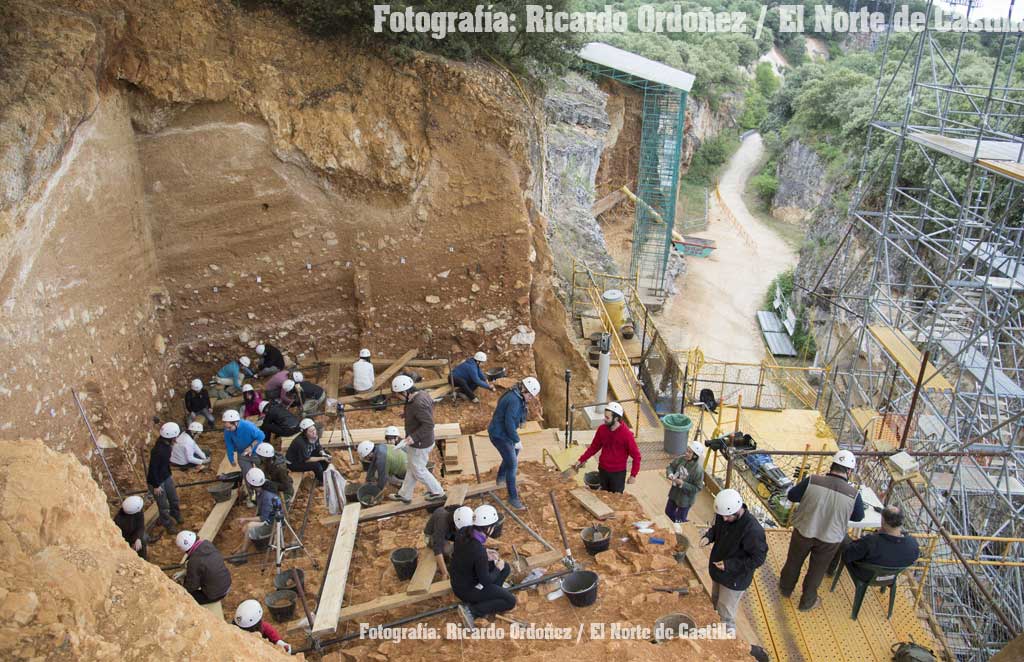The Atapuerca Mountains are 15 kilometers from the city of Burgos, in the Arlanzón River Valley. A long hill, approximately 1000 meters above sea level, overlooks the landscape. In its unassuming depths, generous in game and natural shelters, a few human beings took refuge at the dawn of humanity. A series of paleontological and archaeological sites are found here that are exceptional for both their quality and quantity. These sites have been the subject of an ongoing research project since their scientific discovery in 1978, given the distinctiveness of this natural enclave, inhabited ever since the era of the first hunters.
The Espacio Cultural Sierra de Atapuerca (Atapuerca Mountains Cultural Space) includes the archaeological zone of Atapuerca, where there are 31 archaeological sites (21 in Ibeas de Juarros, four in Atapuerca, and four others between the two villages), as well as 21 additional sites located in other villages, raising the total to 52.
Pleistocene Sites in the Atapuerca Mountains. These are the oldest sites in the area and the ones with the greatest international recognition and fame.
- La Trinchera del Ferrocaril site. This includes the sites found during the clearings cut for the construction of a railroad in the early 20th century. Includes:
- Gran Dolina: The remains of Homo antecessor, over 800,000 years old, were discovered here. These are the remains of six individuals of different ages (children, adolescents and adults). From these remains we have deduced that these humans practiced cannibalism.
- Galería-Tres Simas (Gallery-Three Pits): Immediately next to Gran Dolina is the Galería and the Tres Simas complex, made up of three natural cavities. Remains have been found that show they were occupied by humans 200,000 years ago and 400,000 years ago.
- Sima del Elefante (Elephant Pit): This site is found in the Trinchera del Ferrocarril (Railway Cutting) itself. This is the spot where the oldest traces of human presence have been found, dating back over 1.2 million years. Together with discoveries in Siberia, they represent the oldest evidence of human presence in Euroasia.
- Main Cave Sites. Includes:
- Sima de los Huesos (Pit of Bones): This is a deposit of human fossil remains in a place that is very difficult to access inside the Main Cave, half a kilometer from the entrance, at the foot of a pit 14 meters deep. The great number of bones found there is particularly noteworthy. The majority belong to bears (over 150 individual animals), a few foxes, and the occasional wolf, lynx and ferret. Some 2,500 human fossils of at least 30 Homo heidelbergensis individuals around 300,000 years old have also been found. The remains of "Miguelón” were found here, a discovery which allowed scientist to reconstruct what we were like thousands of years ago with great accuracy.
- Outdoor sites:
- Valle de las Orquídeas: Located in the village of Cardeñuela-Río Pico. Carved remains, fundamentally of flint, were found here.
- Pleistocene terraces: En Ibeas de Juarros, the Arlanzón River terraces are noteworthy for their remains of cut stone industry materials (utensils, carved discards, etc) from the Paleolithic and more recent periods of prehistoric times. Major excavations of flint have been located in Cardeñuela de Riopico and Rubena. Flint was the material most often used by inhabitants of Atapuerca to fashion their implements for hunting and everyday use.
- Hundidero: An outdoor settlement located in Cardeñuela de Río Pico in an old pond on top of an ancient terrace of the Arlanzón River. There are remains from the middle Paleolithic there.
- Hotel California: Human remains have been found at this site on the banks of the Pico River. The Neanderthals surely used these outdoor sites for hunting and harvesting, etc.
More recent Atapuerca Mountains sites: The Pleistocene Epoch discoveries in the Atapuerca Mountains are unique in the world. But that does not diminish the significance of all the later human settlements in the area, which have survived to our times. The most important sites are:
- El Portalón de Cueva Mayor (Portico of Main Cave): Remains from the Neolithic and the very start of the Bronze Age were found here. There were also vestiges of human presence during the Roman era and the early Middle Ages.
- Galería de Sílex de Cueva Mayor (Flint Gallery of Main Cave): Artistic expressions, burial tools and other materials from the Neolithic and Bronze Age were found in this cavern. Human bone remains were found next to the flint working area. Fifty-three panels with schematic depictions, engraved and painted in red, have also been found here. This is part of a funeral ritual, as the existence of rock circles with ashes demonstrates.
- Cueva de El Mirador (Lookout Cave): Remains from the Neolithic up to the Bronze Age were found there.
- Cueva de Silex (Flint Cave): A genuine prehistoric sanctuary, preserved intact since the Bronze Age. Examples of cave art are conserved on the wall, characterized by fine designs, although some feature the technique of red and black paintings. Most are representations of human beings, although some animals are depicted as well.
The Espacio Cultural is seeking to coordinate the management of this entire rich heritage, as well as promote research at these sites, protect them, and also promote and publicize awareness of them in society at large. Among the institutions that are part of this cultural space are the Centro Nacional de Investigación de la Evolución Humana and the Museo de la Evolución Humana in Burgos, as well as the reception and interpretation centers in Ibeas de Juarros and Atapuerca. The Espacio Cultural also incorporates the nearby towns of Rubena, Quintanapalla, Olmos de Atpuerca, Barrios de Colina, San Juan de Ortega, Agés, Santovenia de Oca, Villamorico, Zalduenco, Arlanzón, Villalbura, San Millán de Juarros, San Pedro de Cardeña, San Medel, Castañares, Villafría, Orbaneja Riopico, Cardeñuela, Riopico and Villalval. Above all, they seek the preservation and proper management of this unique enclave in an effort to guarantee its sustainability.










